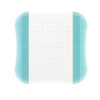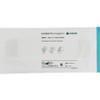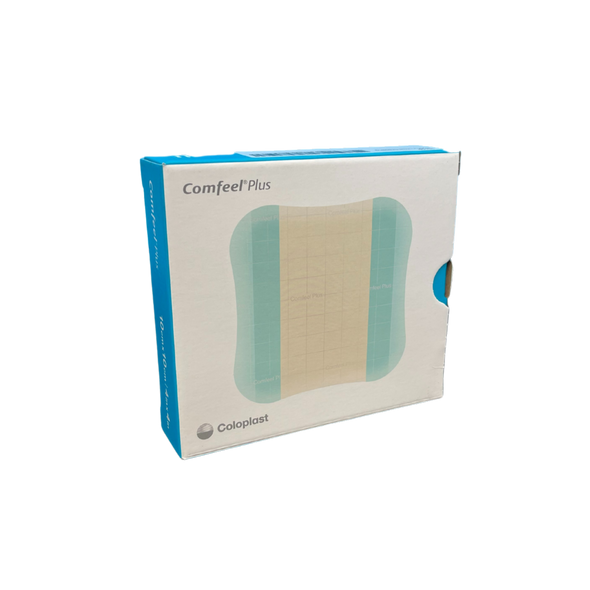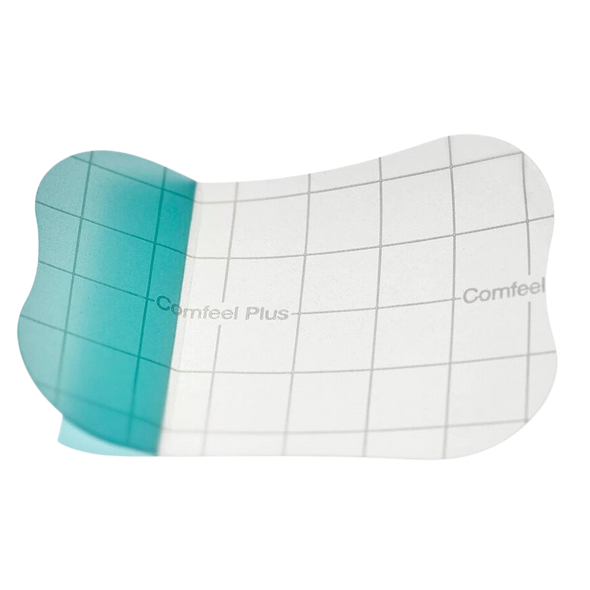Description
Usage
Comfeel Plus Transparent hydrocolloid dressings are indicated for a wide range of none to low exuding wounds. The dressings are indicated for chronic wounds such as leg ulcers and pressure ulcers: and acute wounds such as superficial burns, superficial partial-thickness burns, donor sites, postoperative wounds and skin abrasions. The dressing can stay on for up to 7 days depending on the specific wound characteristics. Comfeel Plus Transparent can be used as a primary as well as a secondary dressing.
Ensured protection
Comfeel Plus Transparent hydrocolloid dressings provide a moist wound healing environment and helps protect the wound in the final stages of wound healing. The top film is water- and bacteria proof to help protect the wound from external factors and smooth to help reduce friction. The semi-permeable top film allows moisture to evaporate while maintaining a moist healing environment.
Wound monitoring
Comfeel Plus Transparent hydrocolloid dressings have a mapping grid for wound monitoring and change indication. The transparency allows you to inspect the wound without removing the dressing. Fewer dressings changes and less wound disturbance support faster healing.
User-friendly design
Comfeel Plus Transparent hydrocolloid dressings have a 3-piece non-touch application system that allows aseptic and controlled application. The turquoise touch points guide the work process. The packaging is designed with life size photos of the dressings for easy product selection and the pouches feature how to use illustrations for optimal guidance.
Mode of action
When the dressing comes into to contact with wound exudate, it forms a viscous gel that absorbs exudate, but does not adhere to the wound bed (1). Excess moisture evaporates through the semi-permeable top film.
Product composition
Comfeel Plus Transparent consists of moisture absorbing sodium carboxymethylcellulose (CMC) particles encapsulated in a synthetic, elastic and stick mass. The top film is a semi-permeable polyeurethane film.
Comfeel Plus Transparent is formulated without pectin, known allergens such as latex or colophony, as well as animal derivatives such as gelatine.
Key benefits
● Hydrocolloid dressing for moist wound healing and protection of skin at risk
● Water-and bacteria proof to protect the wound
● Smooth topfilm and bevelled edges to reduce friction
● Semi-permeable top film to allow moisture to evaporate
● Mapping grid for wound monitoring and dressing change indication
● Transparent dressing allows you to inspect the wound without removing the dressing
● Fewer dressing changes and less wound disturbance support faster healing
● 3-piece non-touch system for aseptic and controlled application
● Turquoise touch points to guide the work process
● New packaging with life-size photo for easy product selection
● Pouch with how to use illustrations for optimal guidance
FAQ
Comfeel is not a type of dressing, but rather a brand name for a range of wound dressings manufactured by Coloplast. Comfeel dressings are designed to manage various types of wounds, such as pressure ulcers, leg ulcers, and diabetic foot ulcers. The dressings are made of a thin, flexible hydrocolloid material that adheres to the skin around the wound, creating a moist environment that promotes healing. Comfeel dressings are available in different shapes and sizes to suit various wound types and locations. It is always important to consult with a healthcare professional for guidance on wound care and dressing selection.
Hydrocolloid dressings are designed to create a moist wound healing environment and can promote healing in certain types of wounds. These dressings are made of a gel-forming material that absorbs wound exudate and forms a gel-like substance, which helps to keep the wound moist and protected from outside contaminants.
Research suggests that hydrocolloid dressings can be effective in promoting healing in certain types of wounds, such as pressure ulcers, diabetic foot ulcers, and leg ulcers. These dressings may also reduce pain and promote faster healing compared to other types of dressings.
However, it is important to note that the effectiveness of hydrocolloid dressings in promoting healing depends on various factors, such as the type and severity of the wound, the patient's overall health, and the proper use of the dressing. It is always best to consult with a healthcare professional for guidance on wound care and dressing selection.
Comfeel dressing is a type of wound dressing that is used to treat a variety of wounds, including pressure ulcers, leg ulcers, diabetic foot ulcers, and other types of wounds. Some of the benefits of Comfeel dressing include:
- Promotes wound healing: Comfeel dressing helps to promote wound healing by creating a moist wound environment, which is essential for the healing process.
- Provides pain relief: The dressing is soft and flexible, which provides cushioning and pain relief for the wound.
- Prevents infection: Comfeel dressing is made with a material that is resistant to bacteria and other harmful microorganisms, which helps to prevent infection.
- Easy to use: Comfeel dressing is easy to apply and remove, which makes it an ideal choice for both healthcare professionals and patients.
- Versatile: Comfeel dressing is suitable for a wide range of wound types and can be used in various parts of the body, making it a versatile option for wound care.
- Can be used for extended periods: Comfeel dressing can be left in place for up to several days, depending on the type and severity of the wound, which can reduce the need for frequent dressing changes.
- Cost-effective: Comfeel dressing is a cost-effective option for wound care, as it can reduce the overall cost of wound treatment by reducing the need for frequent dressing changes and other treatments.
Hydrocolloid dressings may not be suitable for all types of wounds or all individuals. Here are some situations when you should not use hydrocolloid dressing:
- Infected Wounds: Hydrocolloid dressings are not recommended for infected wounds. The moist environment created by the dressing can promote bacterial growth and worsen the infection. If you suspect that your wound is infected, you should consult with a healthcare professional for appropriate treatment.
- Third-Degree Burns: Hydrocolloid dressings are not recommended for third-degree burns or wounds that are heavily exuding or bleeding. These dressings are not able to absorb large amounts of fluid, and may cause the wound to become too moist.
- Allergy: If you are allergic to any of the components of hydrocolloid dressings, you should not use them. Some people may develop an allergic reaction to the adhesive used in the dressing.
- Fragile Skin: Hydrocolloid dressings may not be suitable for individuals with fragile or thin skin, as the adhesive may cause skin damage or tearing upon removal.
- Necrotic Tissue: Hydrocolloid dressings may not be effective in removing necrotic (dead) tissue from the wound. In such cases, other types of dressings or wound debridement techniques may be more appropriate.
- It is important to consult with a healthcare professional before using hydrocolloid dressings or any other wound care products, as they can provide guidance on appropriate wound care management based on the type and severity of the wound.



























